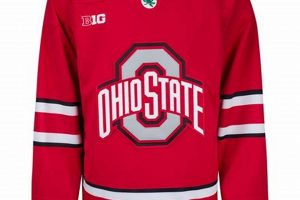Penalty Minutes represents the total duration of penalties a player or team has accumulated during a hockey game or over a season. This statistic is recorded in minutes and reflects the time a player spends off the ice serving a penalty for infractions such as tripping, hooking, or slashing. For instance, a player receiving a minor penalty for interference would accrue two penalty minutes.
This metric provides insight into a player’s or team’s discipline and aggression. A high number may indicate a lack of restraint or a tendency to commit penalties, potentially hindering the team’s performance by creating power-play opportunities for the opposing side. Historically, this has been a key indicator used to assess a player’s role as an enforcer or agitator, adding a dimension of physicality to the game. However, in modern hockey, emphasis is often placed on minimizing these occurrences to maintain a competitive advantage.
Understanding this specific aspect of player and team performance is fundamental for analyzing overall game dynamics, predicting outcomes, and evaluating player contributions beyond scoring statistics. Subsequent sections will delve into related metrics, their significance, and how they contribute to a broader understanding of hockey analytics.
Strategies for Managing Penalty Minutes
Effective management of penalty minutes is crucial for optimizing a team’s chances of success. Implementing proactive strategies can minimize detrimental penalties and improve overall discipline.
Tip 1: Emphasize Disciplined Play: Coaching staff should prioritize instilling discipline within the team. Drills and training exercises focusing on proper technique and avoiding unnecessary aggression can reduce the likelihood of penalties.
Tip 2: Foster Situational Awareness: Players must develop an acute understanding of game situations and their impact on penalty risk. Recognizing when to avoid risky plays, especially near the end of periods or during crucial moments, can prevent costly infractions.
Tip 3: Improve Skating and Positioning: Many penalties arise from being out of position or lacking skating speed. Enhancing these fundamental skills enables players to maintain better control and avoid resorting to hooking, holding, or tripping.
Tip 4: Implement Clear Communication: Establishing clear communication channels between players can help prevent retaliatory penalties. Encourage players to report infractions to the referee rather than taking matters into their own hands.
Tip 5: Review Game Footage: Regularly analyzing game footage with players allows them to identify and correct patterns of behavior that lead to penalties. This provides an opportunity for constructive feedback and skill development.
Tip 6: Promote Self-Control: Teach players techniques for managing their emotions and responding calmly to provocation. Controlling frustration and avoiding impulsive reactions can significantly reduce unnecessary penalties.
By implementing these strategies, teams can minimize the negative impact of accumulating penalty minutes, improving their chances of maintaining momentum and securing victories. The focus should always be on disciplined play, situational awareness, and fostering a culture of self-control.
The subsequent section will examine the historical trends associated with penalty minutes and analyze their evolving role in professional hockey.
1. Penalty Duration
Penalty Duration, within the context of what is PIM in hockey stats, represents the temporal measure of a penalty assessed to a player or team. It’s a critical component of PIM, directly affecting the team’s on-ice composition and strategic options.
- Minor Penalties and Two-Minute Intervals
Minor penalties typically result in a two-minute duration, during which the penalized player is removed from play, and the team plays shorthanded. A common example is a penalty for tripping or hooking. These intervals directly add to a player’s or team’s accumulated PIM, and multiple minor penalties can rapidly increase this statistic.
- Major Penalties and Five-Minute Intervals
Major penalties result in a five-minute duration, often assessed for more severe infractions, such as fighting or deliberate attempts to injure. A major penalty not only contributes significantly to a player’s PIM but also carries the risk of further disciplinary action, such as suspensions, based on league rules.
- Misconduct Penalties and Ten-Minute Intervals
Misconduct penalties result in a ten-minute duration and can be given for unsportsmanlike conduct or verbal abuse. While the penalized player is removed from play, the team does not play shorthanded unless a coinciding minor or major penalty is assessed. These penalties significantly inflate a players PIM without directly impacting the teams immediate on-ice strength.
- Game Misconduct Penalties and Expulsion
Game misconduct penalties result in immediate expulsion from the game and carry a ten-minute penalty duration for PIM tracking. These penalties are assessed for severe misconduct, flagrant rule violations, or repeated offenses. A game misconduct not only impacts the current game but can also lead to subsequent suspensions, affecting future games and contributing to the overall PIM count over a season.
In summary, the different penalty durations have varying effects on PIM. The varying penalty types also affect the team’s dynamics during games. Understanding these aspects offers profound insights into player discipline, team strategy, and the overall implications for gameplay.
2. Discipline Indicator
The total duration of penalties, commonly referred to as PIM, serves as a quantifiable metric reflecting a player’s or team’s discipline within the structured framework of a hockey game. Analysis of accumulated penalty minutes offers valuable insights into behavioral patterns and strategic adherence, providing an objective measure of adherence to regulations and the propensity for rule infractions.
- Frequency of Penalties
A high frequency of penalties suggests a recurring issue with discipline, indicating that a player or team consistently violates game rules. This elevated frequency can be indicative of poor decision-making, aggressive tendencies, or inadequate technique. For example, a player consistently receiving penalties for tripping or hooking demonstrates a recurring issue that impacts the team’s ability to maintain a full roster on the ice.
- Types of Infractions
The specific types of infractions committed offer further insight into the nature of disciplinary problems. Penalties for violent actions, such as fighting or high-sticking, may indicate a lack of emotional control, while penalties for technical violations, such as offsides or too many men on the ice, may point to a lack of focus or inadequate communication. Analyzing the distribution of penalty types provides a more nuanced understanding of the discipline-related challenges faced by a player or team.
- Timing of Penalties
The timing of penalties within a game is a critical factor in assessing discipline. Penalties incurred during crucial moments, such as late in a close game or immediately after a goal, can be particularly detrimental. Such ill-timed infractions demonstrate a failure to maintain composure under pressure and can significantly impact the outcome of the game. A team that consistently takes penalties at inopportune moments is likely exhibiting a lack of discipline that extends beyond mere rule violations.
- Impact on Team Performance
The cumulative impact of penalties on team performance provides a tangible measure of the consequences of poor discipline. A team that consistently spends significant time shorthanded is more likely to concede goals and lose momentum, directly affecting its ability to win games. Moreover, the absence of key players due to penalty infractions can disrupt team chemistry and strategic planning. Therefore, a high total indicates a need for improved discipline to optimize on-ice performance and achieve competitive success.
In conclusion, the analysis of PIM as a “Discipline Indicator” transcends a simple tally of penalty minutes. It serves as a diagnostic tool for identifying patterns of behavior, assessing the impact of infractions on team dynamics, and informing strategies for improving player conduct and on-ice performance. By understanding the nuances of penalty frequency, infraction types, timing, and overall impact, teams can make informed decisions aimed at fostering a more disciplined and successful hockey program.
3. Power Play Impact
The accumulation of penalty minutes directly influences power play opportunities, creating a cause-and-effect relationship that significantly impacts game outcomes. When a player incurs a penalty resulting in time spent in the penalty box, the opposing team gains a power play advantage. This advantage typically involves an increase in the number of players on the ice for the non-penalized team, allowing for enhanced offensive pressure and a higher probability of scoring. The frequency and duration of penalties, as reflected in the “PIM” statistic, are thus directly proportional to the opportunities afforded to the opposition’s power play unit.
A team’s ability to capitalize on power play chances is a critical component of successful hockey. A potent power play can convert these penalty-induced advantages into goals, effectively punishing the opposing team’s lack of discipline. For example, consider a team with a consistently high PIM statistic. This team will inevitably provide more power play opportunities to their opponents over the course of a game or season. If those opponents possess a strong power play unit, the team with the high PIM faces a greater likelihood of conceding goals. Conversely, a team that minimizes its PIM reduces the opportunities for the opposition’s power play, limiting their scoring potential and maintaining a competitive edge.
Understanding this connection between PIM and power play effectiveness has practical significance for coaches and team strategists. Coaches use this information to emphasize disciplined play among their players, reducing unnecessary penalties and limiting the opposition’s power play chances. Moreover, the analysis of PIM statistics, in conjunction with power play conversion rates, provides valuable insights into the strengths and weaknesses of both a team’s disciplinary measures and its special teams performance. While controlling penalties is challenging, a disciplined approach combined with a strong penalty kill can mitigate the negative impact of PIM, contributing to improved team performance and a higher probability of success.
4. Aggression Measurement
Within the framework of hockey analytics, the assessment of aggression necessitates an understanding of Penalty Minutes (PIM) as a quantifiable metric. This measurement reflects the frequency and severity of infractions leading to penalties, providing insight into the aggressive tendencies of individual players and teams.
- Fighting Majors
Fighting majors, resulting in five-minute penalties, are a direct indicator of physical aggression. A high frequency of fighting majors suggests a player’s propensity to engage in physical altercations, contributing significantly to their PIM total. Historically, fighting was more tolerated, but contemporary hockey emphasizes skill and speed, leading to stricter enforcement and influencing players to modulate overtly aggressive behavior.
- Roughing Penalties
Roughing penalties, typically resulting in minor penalties, often arise from physical play that borders on illegal contact. These infractions are subjective, often determined by the referee’s interpretation of the force and intent of the contact. A consistent accumulation of roughing penalties can signal a player’s aggressive style, where they push the boundaries of legal physicality, contributing to an elevated PIM statistic.
- Checking Infractions
Illegal checking, including penalties for boarding, charging, and kneeing, reflects aggressive play that disregards player safety. These penalties not only add to a player’s PIM but also carry the potential for supplementary discipline from league officials. The nature and frequency of these infractions provide insight into a player’s tendency to engage in dangerous and overtly aggressive actions.
- Retaliatory Penalties
While not inherently aggressive, retaliatory penalties often stem from an initial act of aggression by an opposing player. Responding with an illegal action, such as slashing or cross-checking, results in a penalty that adds to the PIM total. The willingness to retaliate can indicate a player’s emotional response to aggression, contributing to the overall measurement of aggression, even if indirectly.
The aggregation of these facets provides a comprehensive view of how PIM relates to aggression in hockey. Although PIM is not a definitive measure of aggressionas it also includes technical infractionsit remains a key indicator. It helps to discern a player’s tendency toward physical and rule-breaking actions, guiding team strategy and player evaluation.
5. Game Disruption
The accrual of penalty minutes directly contributes to game disruption, altering the intended flow and competitive balance. The frequency and timing of penalties impact team strategies, player deployment, and overall game momentum, thereby influencing the final outcome. The relationship between these disruptions and penalty minutes is multifaceted, warranting detailed examination.
- Altered Team Strategies
When a player receives a penalty, the team must adjust its strategy to compensate for being shorthanded. This often involves shifting defensive formations, limiting offensive risks, and reassigning player roles. For instance, a team may prioritize clearing the defensive zone and preventing scoring opportunities over attempting to generate offensive plays. Such strategic shifts disrupt the coach’s intended game plan, forcing reactive decisions that may compromise long-term goals. The frequency with which these adjustments must be made is directly proportional to the accumulation of penalty minutes.
- Player Deployment Imbalances
Penalties necessitate changes in player deployment, impacting ice time distribution and line combinations. Key players serving penalties are unavailable, forcing coaches to rely on alternate players who may be less experienced or suited for specific situations. This creates an imbalance in the team’s composition, potentially weakening critical areas such as offensive firepower or defensive stability. Consider a situation where a team’s top defenseman receives a penalty; the coach must then rely on less experienced players, potentially exposing the team to greater scoring threats. The cumulative effect of such imbalances, driven by penalty minutes, can significantly disrupt a team’s ability to maintain consistent performance.
- Momentum Shifts
Penalties often lead to momentum shifts, altering the emotional and psychological dynamics of a game. A penalty against one team can invigorate the opposition, providing a power play opportunity and a potential scoring chance. Conversely, a successful penalty kill can boost the morale of the shorthanded team, galvanizing their defense and inspiring increased effort. These shifts in momentum, triggered by penalty events, can disrupt a team’s rhythm and focus, impacting their ability to execute planned strategies. A well-timed penalty can stall an opponent’s offensive surge, while an ill-timed penalty can derail a team’s own momentum, affecting the overall competitive landscape.
- Increased Scroring Opportunities for Opponents
By giving opponents a power play, the team receiving the penalty gives the opposing team an increased scoring opportunity. This can lead to goal scoring opportunities which can negatively impact a game.
In summary, penalty minutes serve as a key indicator of game disruption, influencing team strategies, player deployment, and momentum shifts. The effective management of penalty minutes is therefore critical for maintaining game control and maximizing the likelihood of success. The consequences of failing to mitigate penalty minutes extend beyond mere statistical deficits, fundamentally altering the competitive dynamics of a hockey game.
Frequently Asked Questions
This section addresses common inquiries regarding penalty minutes in hockey, offering clarity on its interpretation and significance.
Question 1: How are penalty minutes calculated?
Penalty minutes are calculated by summing the duration of all penalties incurred by a player or team during a game or over a season. Minor penalties typically result in two minutes, major penalties in five minutes, and misconduct penalties in ten minutes. Game misconducts also result in ten penalty minutes.
Question 2: What is considered a high number of penalty minutes?
A high number of penalty minutes varies depending on the player’s role and the era of hockey. Historically, enforcers accumulated significantly more penalty minutes. However, in modern hockey, consistently high penalty minutes may indicate a lack of discipline or an overly aggressive style of play.
Question 3: Do penalty minutes directly correlate with poor team performance?
While high penalty minutes can negatively impact team performance by creating power-play opportunities for the opposition and removing players from the ice, a direct correlation is not always guaranteed. A team with a strong penalty kill unit may mitigate the negative effects of high penalty minutes.
Question 4: Are all penalty minutes indicative of aggression?
Not all penalty minutes are indicative of aggression. Some penalties, such as those for offsides or too many men on the ice, are technical infractions unrelated to physical play. However, penalties for fighting, roughing, and illegal checks are direct indicators of aggression.
Question 5: How do coaches use penalty minute statistics?
Coaches use penalty minute statistics to assess player discipline, identify recurring behavioral patterns, and inform strategic decisions. High penalty minutes may prompt coaches to emphasize disciplined play, adjust player roles, or address specific disciplinary issues.
Question 6: Do penalty minutes impact a player’s career?
Yes, penalty minutes can impact a player’s career. While some teams value players who bring a physical edge, excessive penalties can lead to reduced ice time, suspensions, and a negative reputation. Balancing aggression with discipline is crucial for long-term success.
Penalty minutes offer valuable insights into player behavior, team discipline, and game dynamics. Understanding its nuances is crucial for a comprehensive analysis of hockey.
The subsequent section will explore strategies for minimizing the negative impact of penalty minutes on team performance.
Conclusion
This examination of what is PIM in hockey stats has revealed its multifaceted role in assessing player behavior, team discipline, and game dynamics. Beyond a mere tally of penalty minutes, PIM serves as an indicator of aggression, a disruptor of game flow, and a determinant of power play opportunities. Understanding its nuances is crucial for coaches, players, and analysts seeking a comprehensive perspective on hockey performance.
The insights gained from analyzing PIM underscore the importance of balancing physical play with disciplined execution. As hockey continues to evolve, the ability to minimize detrimental penalties while maintaining a competitive edge will remain a critical factor in achieving sustained success. Future analysis should explore the correlation between PIM and other advanced metrics to further refine our understanding of its impact on team outcomes.







